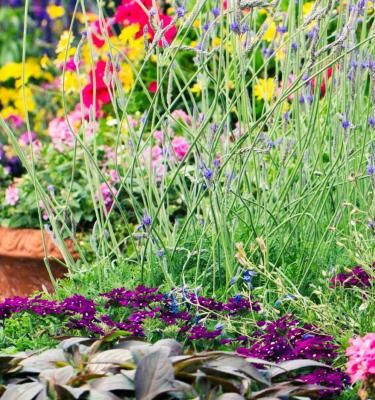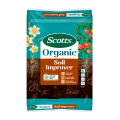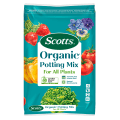Flowers picked fresh from the garden bring vibrancy and life into the home!
A cut flower garden not only looks beautiful, but it’s also so rewarding to gather a few flowers from your own garden to take indoors – whether for yourself, as a gift or to sell for a little extra income. If you like big and showy roses and hydrangeas or the more delicate flowers of orchids and cut-leaf daisies, we have some great cut flower garden design ideas for creating your own cutting garden.
10 Unique Ideas For Making Your Own Cutting Garden
1. Rose Pose
Blooms of roses are a refined addition to any bouquet. They can be used in a mixed display as the feature flower or simply with other roses for a special bouquet. There are thousands of cultivars to choose from with a vast range of fragrances and colours. Hybrid rose plants are a good type to grow for cut flowers, as they tend to produce a single flower on each stem with little foliage.
2. Big, Bold & Beautiful
Large and ostentatious herbaceous peony and kangaroo paw (Anigozanthos) flowers are two striking plants that can be the centrepiece of a cut flower display. Just make sure you provide plants with plenty of sunlight and well-drained soil to ensure repeat flowering. Also consider adding roses to a big and bold display, and sowing sunflowers for an annual crop of cheerful colour.
3. Tropical
Plants from tropical areas are great if you can provide consistent warmth. Orchids, flowering ginger, monstera and anthurium are just a few plants that can provide colour to a cut flower border. These can also be grown inside or at least moved to indoor protection in cooler seasons. Tropical plants usually need humidity, so make sure to provide them with a moist atmosphere, ideally by misting them frequently.
4. Fantastic Foliage
Leaves are sometimes overlooked for a cutting garden but come in all sorts of interesting shapes and sizes. For winter displays consider Ilex aquifolium (holly) and pine (Pinus app.), both suited to a large garden where these trees have plenty of space to grow. For a smaller garden, the fern-like foliage of asparagus and pointed leaves of rosemary, provide something a little different.
5. Wood and Stems
Use the woody parts of a plant to create a long-lasting display. The stems of dogwood (Cornus sanguinea) are notable for their bright colours, coming into their own once the leaves have dropped from them. Consider also bamboo for long, straight stems, and corkscrew hazel (Corylus avellana ‘Contorta’) for its twisted branches.
6. Traditional
Going for a traditional mix of cottage garden plants is a tried-and-tested way of producing flower arrangements of old favourites. Hydrangea, roses and astilbe are popular and familiar in bouquets, and for good reason – with dense blooms of colour, these perennial plants are a reliable source of colour for florists around the world.
7. Succulents
For something more unusual, use the fleshy leaves of succulents in your display. Agave americana and snake plants have long pointed leaves that look great as a backdrop to colourful flowers. String of pearls offer threads of small plump balls which can be draped around or across a display.
8. Go Local
Choose native flowers for a display that will be naturally suited to your local climate. This is helpful to beneficial pollinators and reduces the environmental impact of transporting flowers from other climates. Kangaroo paw, everlasting daisies, banksia and grevillea are just a few of the thousands of plants native to Australia which can be grown for their flowers.
9. Go Global
Theming your cut flower selection on a particular continent can make for bouquets of quite unusual looking flowers. Focus on Mediterranean plants from Europe such as Lavender and Agapanthus, or try some of the large flowering shrubs from across Africa such as pincushions (Leucospermum spp.) and Leucadendron for their showy bracts.
10. Fragrance and Aroma
Breathing in the heady smells of a mixed bouquet of flowers provides indescribable joy. Choose heavily scented roses, lavender, boronia, lilac and tuberose for pretty and aromatic flowers. If possible grow these near to the home or patio to enjoy the fragrances outdoors too. They can be used as part of a mixed bouquet or picked more sparingly and used in a small and subtle dinner table display.
How To Make A Cut Flower Bouquet
- Pick a theme. Choose two or three colours that complement each other. Reds, pinks and purple work well together, as do white with different shades of green. Try to choose flowers that are in season right now, as these will usually be cheaper and easier to obtain.
- Select the healthiest flowers. Check that the petals are intact and that foliage is fresh and lush, showing no spoilage or signs that they are beginning to die back. This is much easier to do if picking from your own cut flower garden, as you can select them when they are looking at their very best.
- Cut the flowers and foliage. Pick flowers by cutting the stem just above a leaf or set of leaves, and at an angle rather than straight across. Pick foliage close to the main stem where possible. Remove thorns and any foliage which would otherwise sit beneath the water, and immediately place them in a temporary container of clean, cold water.
- Arrange the feature flowers. Decide which flowers will be the centrepiece of the display, holding them upright and adding other flowers around them. Rotate the bouquet as you add the supporting flowers to create an even arrangement. Once the flowers are in place, add foliage as needed to soften the display.
- Secure the bouquet. Use floral wire or tape to tie the stems together. This will keep the flowers arranged as intended. The floral wire should be used, discretely, beneath the flower heads. Tape comes in a range of different colours, so choose one which will match the colour theme of the bouquet, or use a shade of green that will blend in with the stems.
- Embellish the display. Add any final touches, such as ribbon or a decorative cellophane-type wrap, to complete the bouquet. Make sure the colour of these embellishments complements the rest of the bouquet. Place the cut flower bouquet away from direct heat and light, and change the water each day.
6 Steps Guide: Planting Your Own Cutting Flowers
Follow our simple steps to create your own cut flower garden:
1. Choose a location
Identify an area of the garden that receives a lot of light, ideally six hours or more each day. The location should be free of uneven shade and should allow easy access to maintain and cut the flowers. A long narrow border, circular border, or plain square can all work well. Mark out the bed with stakes around the edge, and connect them with string or twine to clearly define the area.
2. Prepare the border
Remove all weeds and grass from the marked-out area, so that the space is clear of anything other than soil. Add Scotts Osmocote® Compost Premium Soil Improver to provide a boost to the soil.
3. Choose your flowers
Use our handy growing guides to choose the plants which will produce the flowers and foliage that you want to use in your bouquets. Write out a list of the plants, noting next to each entry the eventual height of the plant, the recommended spacing between plants, and the time of year when it flowers.
4. Design the border
Measure the marked border, and draw it up to scale using a pencil and a sheet of paper. Use gridded paper if you have it, and keep an eraser handy as you are sure to want to change things and replan as you go. Use the list of chosen flowers you created earlier with their space requirements to begin to decide what will go where. Cut flowers are often planted close together to encourage long, upright stems, but you need to maintain good air flow for healthy plants. It makes sense to plant the shorter ones towards the front of a border to allow light to reach them, with taller plants tucking in behind.
5. Plant the border
Follow the plan you have created to position the plants, in their pots, on the border area. Begin at one end of the border and methodically work towards the other end of the bed (or towards the outer edges, if planting in a circular shape). Water well until established, and stake or support as needed to help them grow upwards.
6. Cut your own flowers!
Once flowers start to appear, begin to cut them and create your own arrangements. Always leave at least two-thirds of the plant intact, so that it can continue to produce new growth. Add a feed to the soil to boost the health of cut flower plants, ideally just after you have picked from them. We recommend Scotts Osmocote® Plus Organics Roses, Gardenias & Azaleas Plant Food & Soil Improver or Scotts Performance Naturals™ All Purpose Organic Based Fertiliser.








